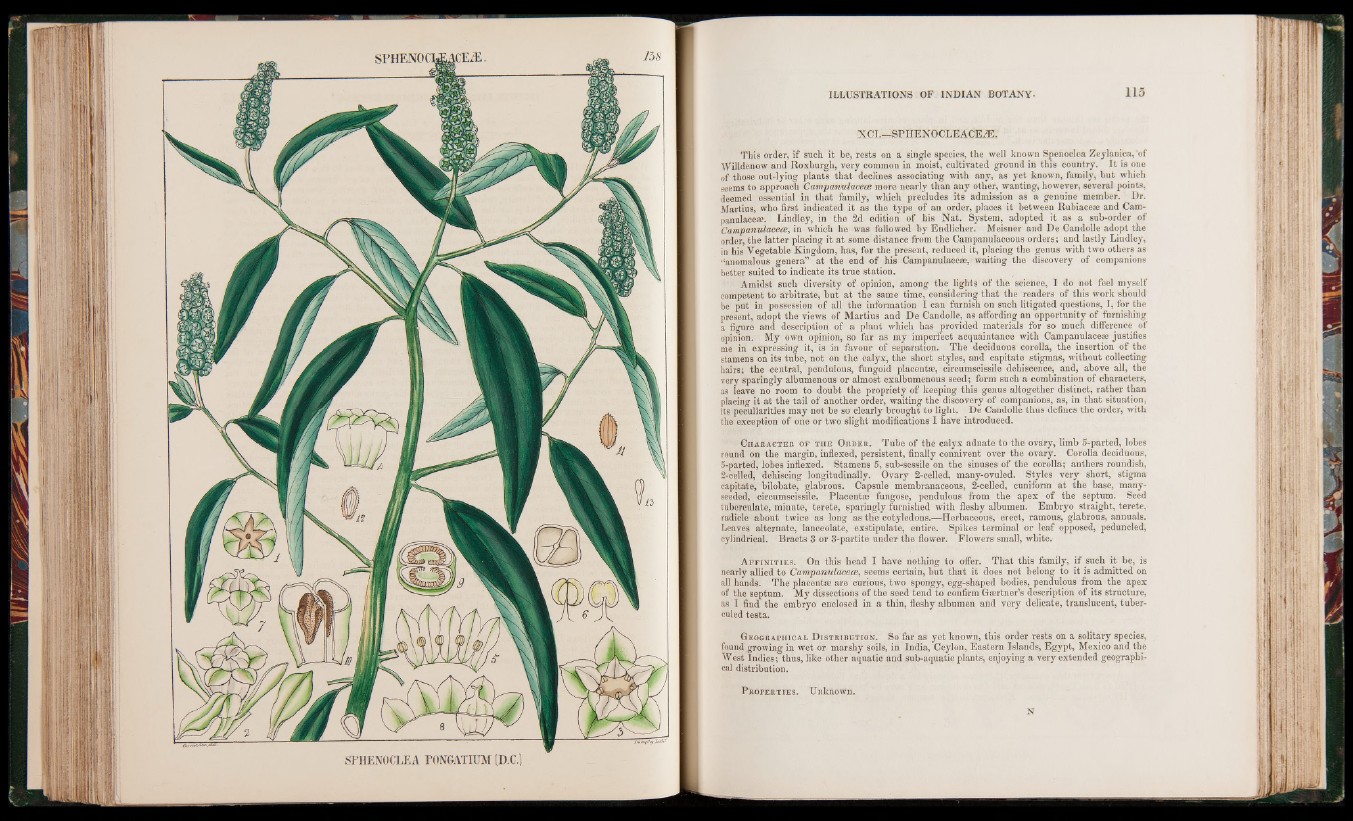
XCI.—SPHENOCLEACEAE.
This order, if such it be, rests on a single species, the well known Spenoclea Zeylanica, of
Willdenow and Roxburgh, very common in moist, cultivated ground in this country. It is one
of those out-lying plants that declines associating with any, as yet known, family, but which
seems to approach Campanulacem more nearly than any other, wanting, however, several points,
deemed essential in that family* which precludes its admission as a genuine member. Dr.
Martius, who first indicated it as the type of an order, places it between Rubiacese and Cam-
panulaceae. Lindley, in the 2d edition of his Nat. System, adopted it as a sub-order of
Campanulacece, in which he was followed by Endlicher. Meisner and De Candolle adopt the
order, the latter placing it at some distance from the Campanulaceous orders; and lastly Lindley,
in his Vegetable Kingdom, has, for the present, reduced it, placing the genus with two others as
“anomalous genera” at the end of his Campanulacese, waiting the discovery of companions
better suited to indicate its true station.
Amidst such diversity of opinion, among the lights of the science, I do not feel myself
competent to arbitrate, but at the same time, considering that the readers of this work should
be put in possession of all the information I can furnish on such litigated questions, I, for the
present, adopt the views of Martius and De Candolle, as affording an opportunity of furnishing
a figure and description of a plant which has provided materials for so much difference of
opinion. My own opinion, so far as my imperfect acquaintance with Campanulacese justifies
me in expressing it, is in favour of separation. The deciduous corolla, the insertion of the
stamens on its tube, not on the calyx, the short styles, and capitate stigmas, without collecting
hairs; the central, pendulous, fungoid placentae, circumscissile dehiscence, and, above all, the
very sparingly albumenous or almost exalbumenous seed; form such a combination of characters,
as leave no room to doubt the propriety of keeping this genus altogether distinct, rather than
placing it at the tail of another order, waiting the discovery of companions, as, in that situation,
its peculiarities may not be so clearly brought to light; De Candolle thus defines the order, with
the exception of one or two slight modifications I have introduced.
Character, of the Order. Tube of the calyx adnate to the ovary, limb 5-parted, lobes
round on the margin, indexed, persistent, finally connivent over the ovary. Corolla deciduous,
5-parted, lobes indexed. Stamens 5, sub-sessile on the sinuses of the corolla; anthers roundish,
2-celled, dehiscing longitudinally. Ovary 2-celled, many-ovuled. Styles very short, stigma
capitate, bilobate, glabrous. Capsule membranaceous, 2-celled, cuniform at the base, many-
seeded, circumscissile. Placentas fungose, pendulous from the apex of the septum. Seed
tuberculate, minute, terete, sparingly furnished with deshy albumen. Embryo straight, terete,
radicle about twice as long as the cotyledons.—Herbaceous, erect, ramous, glabrous, annuals.
Leaves alternate, lanceolate, exstipulate, entire. Spikes terminal or leaf opposed, peduncled,
cylindrical. Bracts 3 or 3-partite under the dower. Flowers small, white.
Af f in it ies . On this head I have nothing to offer. That this family, if such it be, is
nearly allied to Campanulacece, seems certain, but that it does not belong to it is admitted on
all hands. The placentae are curious, two spongy, egg-shaped bodies, pendulous from the apex
of the septum. My dissections of the seed tend to condrm Gaertner’s description of its structure,
as I dnd the embryo enclosed in a thin, deshy albumen and very delicate, translucent, tuber-
culed testa.
Geographical Distribution. S o far as yet known, this order rests on a solitary species,
found growing in wet or marshy soils, in India, Ceylon, Eastern Islands, Egypt, Mexico and the
West Indies; thus, like other aquatic and sub-aquatic plants, enjoying a very extended geographical
distribution.
P roperties. Unknown.
N